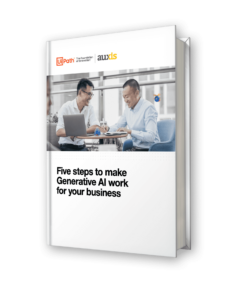At this point, you’ve probably heard the tantalizing promise: RPA ROI is achieved in less than a year – generating faster turnaround times, lower operating costs, improved compliance, and higher quality of work. PwC estimates that 45% of work activities can be automated, saving $2 trillion in global workforce costs.
In the post-pandemic era, this ability to deliver quick benefits is more important than ever. Forrester Research predicts automation like Robotic Process Automation (RPA) will be key to prospering in the new normal – as enterprises scramble for ways to ensure business continuity and revenue enablement without overhauling legacy systems.
But many organizations struggle to achieve the value they need from automation. Implementation is harder than it looks: More than 60% of RPA journeys stall after automating 10 or fewer processes – and 30-50% of projects fail altogether.
Speeding up payback can be key to guaranteeing RPA success – ensuring you don’t lose momentum or organizational buy-in. ROI varies from project to project – obviously, implementing robots to take over highly repetitive, error-prone work from 20 FTEs will deliver bigger, faster payback than automating a more complex process performed by fewer people.
But as a rule, three important pillars are essential to accelerating your RPA return on investment. Unfortunately, most companies don’t realize how easy it is to optimize their payback period by putting these pillars in place before their automation journey starts.
Let’s dig into the three key areas that can help organizations speed RPA ROI – and what you need to do to get them right.
1. The right people – In-house teams often look good on paper but can delay ROI in RPA.
An outstanding human team is key to a successful RPA implementation. But too many RPA projects derail because the organization wrongly believed that building an in-house team instead of hiring a third-party provider was the secret to lower costs and faster payback.
In-house teams can be cost-effective for large global organizations, where even small productivity gains can lead to significant cost savings. But most companies fail to realize that recruiting and training a specialist technology workforce comes with high costs – requiring a substantial pipeline of projects to drive the RPA ROI you need.
Implementing RPA requires a new set of skills to effectively design, monitor, and optimize usage of the bots. Unfortunately, the newness of RPA technology combined with the severe IT labor shortage makes it unlikely these skills are available in-house – generating high demand for scarce resources that drives salaries and turnover rates sky-high.
The U.S. Bureau of Labor Statistics predicts there will be a million more job openings in computing than qualified applicants this year. With so much opportunity, the tech industry suffers a churn rate of 13.2% – the highest of any business sector. Replacing IT employees generally costs a whopping 100-150% of their annual salary, including lost productivity and the headache of recruiting, training, and onboarding a new hire.
Training in-house staff to implement RPA is possible but comes with a steep learning curve that increases project costs and timelines. Quality is also likely to suffer: Inexperienced RPA teams often underestimate the complexities of automation or fail to anticipate process exceptions that impact bots’ productivity – and ROI.
A successful RPA journey requires an RPA Center of Excellence (CoE) that combines business process experts, enterprise architects, and innovation leaders tasked with designing, building, and maintaining a company’s process robots. While building your CoE in-house can look good on paper, make sure you carefully analyze the variables and risks that can cause costs to spiral beyond your initial expectations. For most companies, a hybrid model that leverages the resources, knowledge, and experience of a third-party RPA provider with the business expertise of in-house staff delivers the best RPA ROI.

2. The right platform – How to choose the technology that will deliver the best RPA return on investment for your business.
The right automation technology will deliver the fastest payback period. But while the tools that are leaders in the market offer a similar baseline of features, there are key differences – from the types of bot they offer to the ease of connection with other technology. Those differences impact your ability to scale and control your RPA program and quantify the benefits you are getting.
The best implementation partner in the world can’t compensate for software that’s ill-suited to your organization’s needs. Consider these key criteria for choosing the platform that will deliver the best RPA ROI for your company:
- Scalability. Scale is essential to accelerating the RPA payback period. Unfortunately, it’s proved elusive to most companies. Deloitte reports that only 3% of organizations that start an RPA journey achieve any form of scale. Products with end-to-end capabilities – from process mining to performance reporting – offer the capability to easily scale, with everything you need to grow your RPA program in a single platform.
- Accessibility. RPA is designed to function like a human worker, creating a communication bridge between separate IT systems. But assuming every RPA software is compatible with every technology can lead to unfortunate surprises – for instance, some RPA tools have struggled to connect with virtualized environments. When choosing a platform, look for tools that easily integrate with the widest array of systems.
- Diverse functionalities. Many business leaders are surprised to learn that every robot isn’t the same. Attended bots reside at individual workstations and are best suited to tasks that require some input from the user, entirely depend on the user’s computer, or are executed on-demand like during customer-facing situations. Unattended bots deliver the greatest ROI because they can execute tasks and interact with applications independent of human involvement. RPA platforms that offer both models enable organizations to automate the broadest range of processes at the lowest cost.
3. The right support – The greatest ROI in RPA comes from long-term success.
Robots are never a “set it and forget it” investment – unexpected process exceptions like changes to an external website will inevitably require adjustments. But too many organizations neglect to create a separate RPA support structure, wrongly assuming developers can maintain the bots.
But ongoing maintenance and support require a different set of skills than design and implementation. Organizations underestimate the amount of support required to ensure a smooth RPA program as well, distracting high-value resources from innovating. Turnover also tends to increase when developers are forced to perform more monotonous support tasks.
Broken bots that languish before they are fixed eat into RPA ROI. A solid support structure that can guarantee 24/7 operation of your bots is key to long-term automation value. It also allows you to rely on consistent returns to expand your RPA program.
Many organizations find that leveraging a third-party is the best way to provide support. That way, they can safeguard their investment and optimize ROI without having to carry a pricey in-house team without a consistent pipeline of work.
Speeding RPA ROI delivers the momentum you need to spread the benefits of RPA company-wide
RPA is increasingly becoming an enterprise-level opportunity. The positive experience reported by many organizations with function-specific RPA programs prompted 64% to reimagine automation as a broader strategic initiative, up from only 15% the year before, Deloitte reports. Speeding the payback period delivers the momentum you need to grow your RPA program, delivering an innovation advantage that can help your business flourish amidst post-pandemic challenges.





